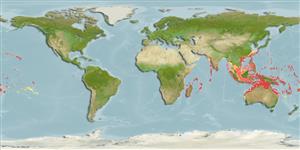Environment: milieu / climate zone / depth range / distribution range
Οικολογία
Θαλασσινό(ά) Υφαλόφιλο(α); εύρος βάθους 4 - 100 m (Ref. 6390). Tropical; 30°N - 33°S, 33°E - 134°W (Ref. 5222)
Indo-Pacific: Kenya to Delagoa Bay, Mozambique, eastward to the Tuamoto Islands, north to the Ryukyu Islands, south to Queensland, Australia and including most islands of the Indian Ocean and of western and central Pacific. Unknown in the Red Sea and Persian Gulf. Misidentified as Plectropomus maculatus by some authors (Ref. 6448, 6892).
Length at first maturity / Μέγεθος / Βάρος / Age
Maturity: Lm ?, range 60 - ? cm
Max length : 125 cm TL αρσενικό/απροσδιόριστο; (Ref. 30573); common length : 84.0 cm SL αρσενικό/απροσδιόριστο; (Ref. 37816); μεγ. δημοσιευμένο βάρος: 24.2 kg (Ref. 40637)
Ραχιαίες άκανθες (συνολικά): 7 - 8; Μαλακές ραχιαίες ακτίνες (συνολικά): 10-12; Εδρικές άκανθες 3; Μαλακές εδρικές ακτίνες: 8.
A voracious piscivore inhabiting coral-rich areas of lagoon and seaward reefs. Encountered most frequently in channels and outer shelf reefs. Migrate over short distances to spawn, forming large aggregations, maybe 1 or 2 per reef (Ref. 6390). Feeds mostly on fishes, and occasionally on crustaceans (Ref. 9710). The prey comprises a variety of large reef fishes, including groupers, and this diet of large fishes is responsible for the high concentrations of ciguatera toxins. Juveniles may mimic the pufferfish Canthigaster valentini. Usually wary (Ref. 9710). The young have a demersal existence in shallow water in reef habitats, especially around coral rubble (Ref. 27259). They feed on small fish and invertebrates such as crustaceans and squid (Ref. 27261). Eggs float just below the surface (Ref. 6390). The pelagic larvae are found in habitats similar to those of the adults (Ref. 27260). An excellent table fish (Ref. 6390).
Heemstra, P.C. and J.E. Randall, 1993. FAO Species Catalogue. Vol. 16. Groupers of the world (family Serranidae, subfamily Epinephelinae). An annotated and illustrated catalogue of the grouper, rockcod, hind, coral grouper and lyretail species known to date. Rome: FAO. FAO Fish. Synop. 125(16):382 p. (Ref. 5222)
IUCN Red List Status (Ref. 130435)
Threat to humans
Reports of ciguatera poisoning (Ref. 1602)
Human uses
αλιεία: Εμπορικό(ά); αλιεία αναψυχής: ναί
Περισσότερες πληροφορίες
ΑναφορέςΥδατοκαλλιέργειεςΠροφίλ υδατοκαλλιέργειαςΣτελέχοιΓενετικήElectrophoresesΚληρονομικότηταΑσθένειεςΜεταποίησηNutrientsMass conversion
Εργαλεία
Special reports
Download XML
Διαδικτυακές πηγές
Estimates based on models
Preferred temperature (Ref.
123201): 25.5 - 28.9, mean 27.6 °C (based on 276 cells).
Phylogenetic diversity index (Ref.
82804): PD
50 = 0.5078 [Uniqueness, from 0.5 = low to 2.0 = high].
Bayesian length-weight: a=0.01000 (0.00609 - 0.01643), b=3.07 (2.93 - 3.21), in cm total length, based on LWR estimates for this species & (Sub)family-body (Ref.
93245).
Τροφικό Επίπεδο (Ref.
69278): 4.1 ±0.57 se; based on food items.
Ελαστικότητα (Ref.
120179): Μεσαίο(α), ελάχιστος χρόνος για διπλασιασμό πληθυσμού 1,4 - 4,4 έτη (Preliminary K or Fecundity.).
Fishing Vulnerability (Ref.
59153): High vulnerability (61 of 100).
Nutrients (Ref.
124155): Calcium = 20.8 [13.2, 35.1] mg/100g; Iron = 0.482 [0.266, 0.777] mg/100g; Protein = 18.7 [16.9, 20.3] %; Omega3 = 0.133 [0.090, 0.206] g/100g; Selenium = 47.6 [28.5, 84.4] μg/100g; VitaminA = 76.1 [28.9, 230.2] μg/100g; Zinc = 0.698 [0.493, 0.988] mg/100g (wet weight);
